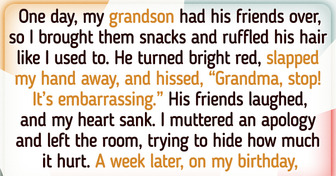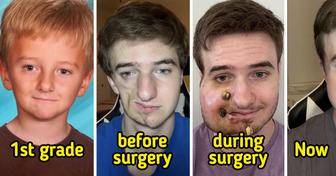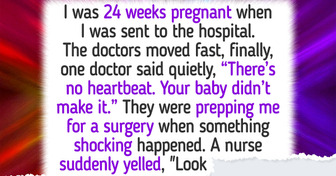I Will Not Look After My Stepchild During a Romantic Getaway

You’ve finally made it! After all that training, you’re ready for your first skydive. Full of confidence, you reach the door of the plane as it gets to 12,000 feet. You step off into the air, but at the last second, you hear the instructor screaming something [instructor yells, “I didn’t check your chute!”]. You can’t hear him as you drop away from the plane, seeing only his concerned expression.
Well, it feels like something has gone wrong! You pull the handle to release the parachute. But it hasn’t deployed correctly, opening into a big wad, and you’re now spinning faster and faster! You’re getting dizzy, but you need to pull yourself together. Each second is crucial, and from this altitude, you have less than a minute to act!
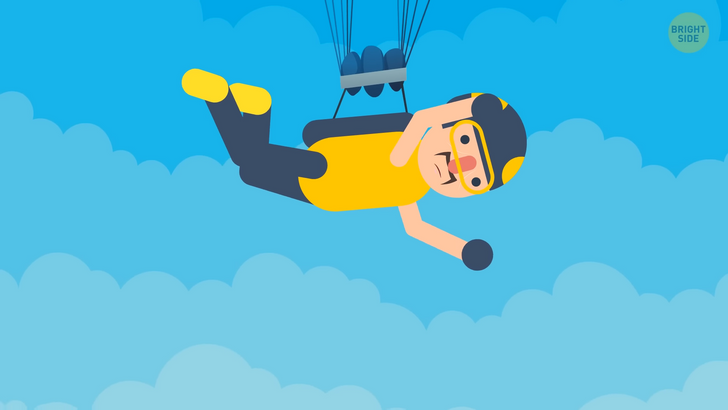
You throw yourself into the “bowman” formation, spreading your body out, with your arms and your legs forming an “X”. This creates a little more drag, allowing you to stabilize a bit. Hey this whole thing is a drag. Now you have more time to get to your emergency reserve chute. Still dizzy from the spinning, you try to remember where it is. You grab what you think is the right strap, and pull it hard, oh no! That’s a leg strap!
You’ve loosened the container on your back, and now you’re slipping out! This is not your lucky day. You hold on and tighten up the leg strap. Oh yeah, the safety procedure is coming back to you now. Step 1: Cutaway from the main parachute with the red handle. Done. Now you’re in free fall again. Step 2: Now, find the silver ripcord handle to pop the reserve chute! Gotta hurry. The ground is rushing up at you. Where’s that handle! Whoops there it is, sitting on your chest on the left. You yank it hard.
Ka thump! The chute flies out and deploys and slams the brakes on your descent. Now you’re relieved. Breathtaking? Heart pounding? Oh, yeah. Finally, you can enjoy the view... for about 10 seconds before you land on the ground. Softly. Feet first. Hey looks like fun. Sign me up. As always, instead of taking the stairs, you use the elevator. The odds of it failing are 1 in 10 million.
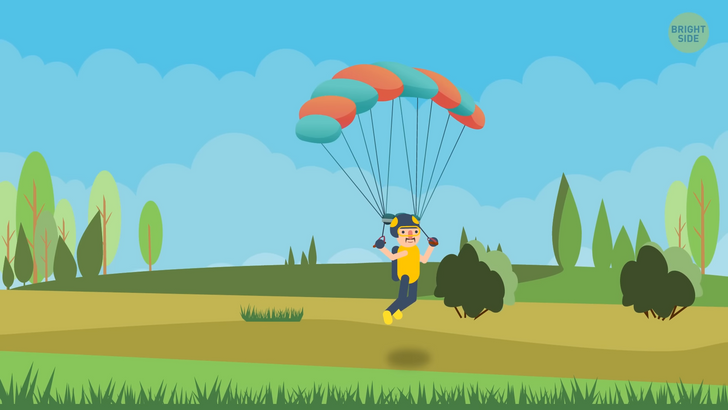
You’re ten times more likely to be hit by lightning! But today, you’re in that unlucky elevator. As you move down from the fifth floor, the pulley system fails, a cable snaps and the elevator starts falling. Quickly, you lie down on your back, placing one arm around your head to protect it from the impact and the other arm over your face to save it from possible falling objects. You spread your legs out evenly. In just a couple of seconds, you brace for impact. It crashes down, and debris from above falls around you. Fantastic job — you’ve avoided injury.
But could it be possible to alter the impact by jumping? Let’s think this through. If you jumped too early, your impact would be more severe as your speed would increase in the descent. And if you jumped too late, the velocity of your jump upwards would cause you to bump your head as the elevator would have stopped. You’d need to jump at the precise moment to be effective in velocity. And without the ability to see through steel, it would be down to sheer luck. So it’s better to use the lie-down method. Good luck with that.
You casually drive to work, passing over the same bridge as any other day. Today there’s more traffic than normal, and you’re stuck in a jam. The bridge starts to creak. Unfortunately, it’s possible for structurally faulty bridges to collapse under excess weight. And there you are. As the bridge falls into the river, your car floats on top. The water is slowly rising around you as it starts to sink. You’re trying to remain calm and take a deep breath. You have up to 2 minutes before the car completely sinks. You need to act fast and roll down the window.
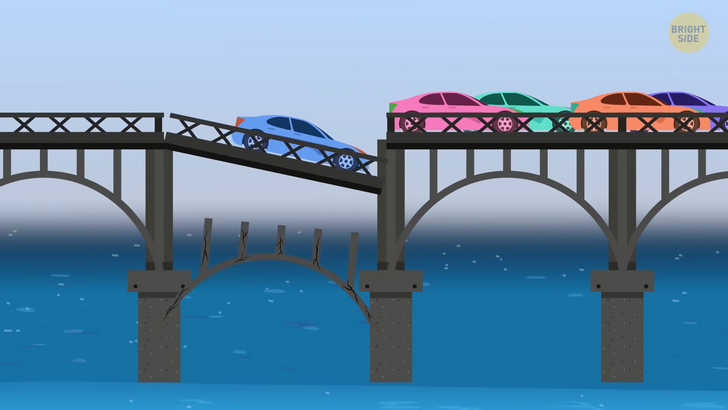
As you take off your seat belt, you notice the water has risen above the windows! You try to roll them down, but they’re stuck in place from the pressure. You’ve missed your opportunity! You’re sinking further down and think about opening the door. Hmm, better not. This will make your vehicle sink even faster. Plus, it will be more dangerous to exit.
The car hits bottom, and the water is slowly entering it. You try to open the door, but the pressure is so intense that it won’t budge! You think about the water coming in. Maybe if you waited until there’s enough water inside, it could regulate the pressure, allowing the doors to open. But with the limited air that would remain, and if the doors still don’t work, it’s too much of a risk.
Your only choice is to smash the window. You do it easily due to the water pressure, and it spills in quickly. You take your last deep breath while holding onto the window frame. The car fills in quickly, and the suction suddenly stops. You pull yourself through the window and place your feet on the car, push upwards, and swim to the surface. Yeah. Remind me not to car-pool with you.
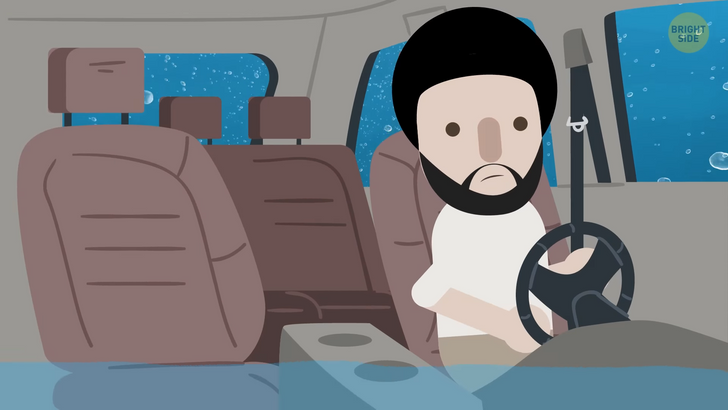
Next, you’re out hiking in a forest and find the perfect place to view the sunset. You take a photo, and it looks great! But wait, which way is it back to camp? It’s getting dark, and you have no idea how you got here! You check your phone. It has a map, so you’ll be fine, right? But you’ve taken way too many nature pics, and the battery has run out!
You can survive up to 3 hours without shelter in harsh weather. You can go without water for 3 days. And up to 3 weeks without food. You need to address your next actions in order of importance. Your first task is to build a shelter. You lean a large stick onto a tree for the roof’s support. Then, you build two walls on the sides, making a sturdy frame. There are plenty of leaves in the forest, and you cover the roof with heaps of them for insulation and protection. On the inside, you build a nice leafy mattress. You enter and wait until morning, hoping to have a relaxing sleep.
You’ve slept horribly, but there’s no time to leave a review on your booking app. The next task is finding water. You follow a clear decline in the land, eventually finding a stream. Clean water, check! You continue to walk with the stream’s flow, hoping it leads you to a river. You are more likely to find people and signs of civilization along large collections of water. Hours pass, and your belly grumbles. You look around for tasty snacks. There are berries and mushrooms, but you don’t recognize them. It’s better not to eat something if you’re unsure whether it’s poisonous. You search under old logs and branches for bugs.
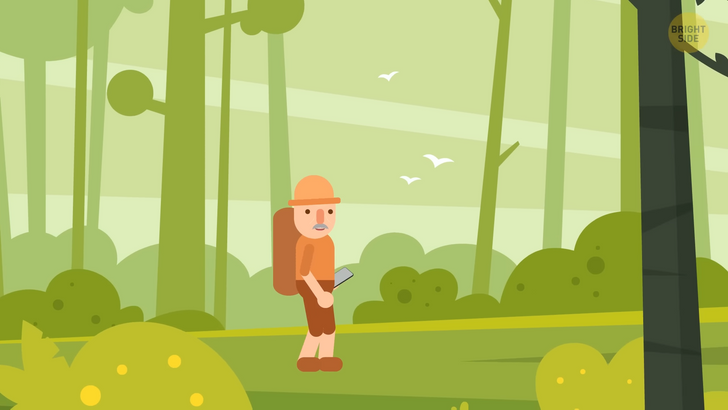
You’ve found some meal worms that can be eaten raw. Some insects, when cooked, can be a major source of iron, protein, and vitamin B12. You look at them, and your appetite goes away, “hmm, maybe later...” Finally, the stream connects to a river, and just ahead of that, a bridge! Not the one that fell down. The struggle is over. You throw the bugs away and begin the next adventure, finding a diner! Yeah, we’re not going camping together either. You’re walking in a field; the wind is picking up, and not far away, a tornado is forming. You start running away from it, but you can’t outrun it, as it travels up to sixty mph.
Your main concern isn’t the tornado itself but the trees and buildings that the twister takes in, turning them into dangerous flying objects. They fly at crazy speeds as they’re carried by fast winds, reaching up to three hundred mph. You look for shelter, but there’s nothing available. Your only possibility is a ditch that’s not surrounded by trees or other breakable objects. You lie wedged in the ditch and cover your head with your jacket, holding it down with your arms for protection. While lying flat, with the thundering noise around you, you feel like you’re in a giant jet engine. It’s a terrifying sound, but luckily, you’re not in the tornado’s pathway.
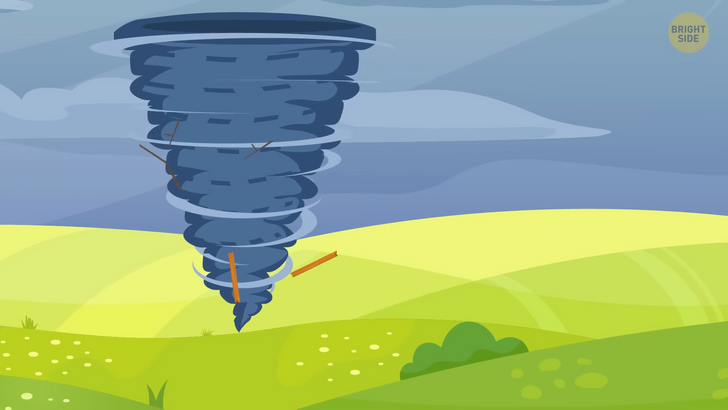
You can hear the small debris whistling over your head, and many make an impact, thudding all around you, but thankfully they miss. Everything goes calm. You lie there controlling your breathing, trying to relax. You don’t get up, not yet, as the worst may be yet to come.
Tornadoes can last from several seconds and up to an hour. You’re not taking your chances and remain in your ditch for the full hour. But finally, when it’s clear that it’s gone, you dust off your jacket and head home. Meanwhile, you’re really bad luck. So I’m removing you from my contacts and unfriending you on social media. And I’ll do that... once I get out of the hospital.


